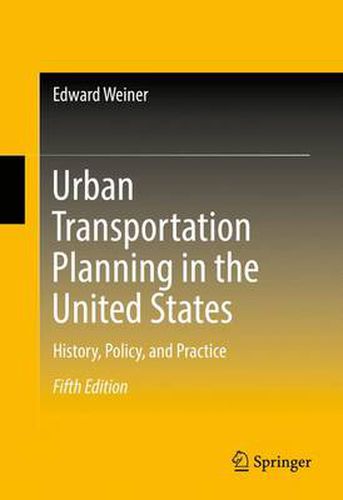Readings Newsletter
Become a Readings Member to make your shopping experience even easier.
Sign in or sign up for free!
You’re not far away from qualifying for FREE standard shipping within Australia
You’ve qualified for FREE standard shipping within Australia
The cart is loading…






This title is printed to order. This book may have been self-published. If so, we cannot guarantee the quality of the content. In the main most books will have gone through the editing process however some may not. We therefore suggest that you be aware of this before ordering this book. If in doubt check either the author or publisher’s details as we are unable to accept any returns unless they are faulty. Please contact us if you have any questions.
In this new fifth edition, there is a strong focus on the increasing concern over infrastructure resilience from the threat of serious storms, human activity, and population growth. The new edition also looks technologies that urban transportation planners are increasingly focused on, such as vehicle to vehicle communications and driver-less cars, which have the potential to radically improve transportation. This book also investigates the effects of transportation on the health of travelers and the general public, and the ways in which these concerns have become additional factors in the transportation and infrastructure planning and policy process. The development of U.S. urban transportation policy over the past half-century illustrates the changing relationships among federal, state, and local governments. This comprehensive text examines the evolution of urban transportation planning from early developments in highway planning in the 1930s to today’s concerns over sustainable development, security, and pollution control. Highlighting major national events, the book examines the influence of legislation, regulations, conferences, federal programs, and advances in planning procedures and technology. The volume provides in-depth coverage of the most significant event in transportation planning, the Federal-Aid Highway Act of 1962, which created a federal mandate for a comprehensive urban transportation planning process, carried out cooperatively by states and local governments with federal funding. Claiming that urban transportation planning is more sophisticated, costly, and complex than its highway and transit planning predecessors, the book demonstrates how urban transportation planning evolved in response to changes in such factors as the environment, energy, development patterns, intergovernmental coordination, and federal transit programs. This new edition includes analyses of the growing threats to infrastructure, new projects in infrastructure resilience, the promise of new technologies to improve urban transportation, and the recent shifts in U.S. transportation policy. This book will be of interest to researchers and practitioners in transportation legislation and policy, eco-justice, and regional and urban planning.
$9.00 standard shipping within Australia
FREE standard shipping within Australia for orders over $100.00
Express & International shipping calculated at checkout
This title is printed to order. This book may have been self-published. If so, we cannot guarantee the quality of the content. In the main most books will have gone through the editing process however some may not. We therefore suggest that you be aware of this before ordering this book. If in doubt check either the author or publisher’s details as we are unable to accept any returns unless they are faulty. Please contact us if you have any questions.
In this new fifth edition, there is a strong focus on the increasing concern over infrastructure resilience from the threat of serious storms, human activity, and population growth. The new edition also looks technologies that urban transportation planners are increasingly focused on, such as vehicle to vehicle communications and driver-less cars, which have the potential to radically improve transportation. This book also investigates the effects of transportation on the health of travelers and the general public, and the ways in which these concerns have become additional factors in the transportation and infrastructure planning and policy process. The development of U.S. urban transportation policy over the past half-century illustrates the changing relationships among federal, state, and local governments. This comprehensive text examines the evolution of urban transportation planning from early developments in highway planning in the 1930s to today’s concerns over sustainable development, security, and pollution control. Highlighting major national events, the book examines the influence of legislation, regulations, conferences, federal programs, and advances in planning procedures and technology. The volume provides in-depth coverage of the most significant event in transportation planning, the Federal-Aid Highway Act of 1962, which created a federal mandate for a comprehensive urban transportation planning process, carried out cooperatively by states and local governments with federal funding. Claiming that urban transportation planning is more sophisticated, costly, and complex than its highway and transit planning predecessors, the book demonstrates how urban transportation planning evolved in response to changes in such factors as the environment, energy, development patterns, intergovernmental coordination, and federal transit programs. This new edition includes analyses of the growing threats to infrastructure, new projects in infrastructure resilience, the promise of new technologies to improve urban transportation, and the recent shifts in U.S. transportation policy. This book will be of interest to researchers and practitioners in transportation legislation and policy, eco-justice, and regional and urban planning.